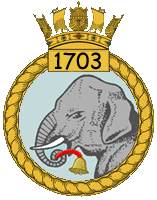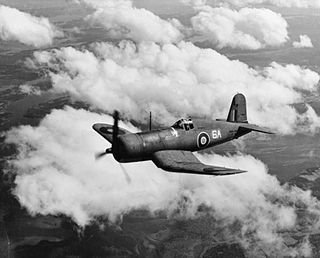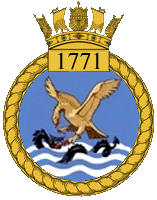| 896 Naval Air Squadron | |
|---|---|
| Active | 1942-1944 1945 |
| Country | |
| Branch | |
| Part of | Fleet Air Arm |
896 Naval Air Squadron (896 NAS) was a Naval Air Squadron of the Royal Navy's Fleet Air Arm. [1]
| 896 Naval Air Squadron | |
|---|---|
| Active | 1942-1944 1945 |
| Country | |
| Branch | |
| Part of | Fleet Air Arm |
896 Naval Air Squadron (896 NAS) was a Naval Air Squadron of the Royal Navy's Fleet Air Arm. [1]

The Fleet Air Arm (FAA) is the naval aviation component of the United Kingdom's Royal Navy (RN). The FAA is one of five RN fighting arms. As of 2023 it is a primarily helicopter force, though also operating the F-35 Lightning II carrier-based stealth fighter jointly with the Royal Air Force.
Royal Air Force Heathfield, or more commonly RAF Heathfield, sometimes known as RAF Ayr/Heathfield due to its proximity to Glasgow Prestwick Airport, which was also used by military flights, is a former Royal Air Force station. It opened in April 1941 as an airbase for day and night fighter squadrons. In September 1944 it transferred to Fleet Air Arm control and commissioned as HMS Wagtail. The Royal Navy paid off the airbase in March 1946 and it was reduced to care and maintenance. The United States Air Force used it for storage between 1951 and 1957, with the designation USAAF Station 570.

Royal Naval Air Station Hatston, was a Royal Naval Air Station, one mile to the north west of Kirkwall on the island of Mainland, Orkney, Scotland. It was located near the strategically vital naval base of Scapa Flow, which for most of the twentieth century formed the main base of the ships of the Home Fleet. The airbase was designed to provide accommodation for disembarked Front-Line squadrons and accommodation for disembarked Ship's Flight Aircraft and was home to the Home Fleet Fleet Requirements Unit, 771 Naval Air Squadron.

Royal Naval Air Station Burscough, was a Fleet Air Arm (FAA) naval air station which was 1.5 miles (2.4 km) southwest of Burscough, Lancashire. The Admiralty acquired 650 acres (2.6 km2) of land in December 1942 and the airfield was built with four narrow runways and several hangars, being commissioned on 1 September 1943.

1701 Naval Air Squadron was a Naval Air Squadron of the Royal Navy's Fleet Air Arm (FAA). It was formed in February 1945 at HMS Daedalus, RNAS Lee-on-Solent, as an amphibian bomber reconnaissance squadron. It was equipped with Supermarine Sea Otter, and the squadron joined HMS Begum in April 1945 bound for the Far East. The squadron was intended to join the newly established Mobile Naval Air Bases for Air Sea Rescue duties. 'B' Flight joined MONAB IV at RNAS Ponam in the Admiralty Islands in May 1945 and embarked in HMS Reaper in October 1945. 'A' Flight joined MONAB VI at RNAS Maryborough, Queensland, Australia in June 1945. The flights re-grouped in the Autumn of 1945 at HMS Nabcatcher, RNAS Kai Tak, Hong Kong, where it disbanded during August 1946.

1702 Naval Air Squadron was a Naval Air Squadron of the Royal Navy's Fleet Air Arm (FAA), which last disbanded during September 1946. It was formed in June 1945 at HMS Daedalus, RNAS Lee-on-Solent, as a Special Service squadron. It was equipped with the Supermarine Sea Otter, and by the end of the Second World War the squadron remained at Lee-on-Solent. It joined HMS Trouncer in September 1945 to search for mines in the Mediterranean. A detachment of three aircraft were aboard HMS Ocean when the squadron disbanded at Malta and this became the Ship's Flight.

1703 Naval Air Squadron was a Naval Air Squadron of the Royal Navy's Fleet Air Arm (FAA). It was formed in August 1945 at RNAS Lee-on-Solent for Air Sea Rescue duties in the Pacific. It was equipped with Supermarine Sea Otter. The Second World War ended in the same month that the squadron was formed, and it never deployed or saw action.

Royal Naval Air Station Eglinton was a Royal Navy airbase located 1.3 miles (2.1 km) north east of Eglinton, in County Londonderry, Northern Ireland. It opened as a Royal Air Force Station in 1941, before being transferred to the Fleet Air Arm in May 1943.
890 Naval Air Squadron was a Naval Air Squadron of the Royal Navy's Fleet Air Arm.

722 Naval Air Squadron was a Naval Air Squadron of the Royal Navy's Fleet Air Arm (FAA) created on 7 September 1944, as a Fleet Requirements Unit, where it was responsible for assisting in ship and aircraft gunnery practice. On 24 October 1945 the squadron disbanded following the end of the Second World War.

732 Naval Air Squadron was a Naval Air Squadron of the Royal Navy's Fleet Air Arm (FAA). It was initially formed in 1943 from a requirement for an Operational Training Unit for United States trained FAA pilots flying Vought Corsair fighter-bomber aircraft, at RN Air Section Brunswick, USNAS Brunswick, Maine, United States, and disbanded during 1944. In 1945 it was reformed for a brief period, as a Night Fighter Training Squadron, operating out of HMS Nighhawk, RNAS Drem, East Lothian, Scotland. Notably equipped with six Avro Anson 'flying classrooms', amongst other aircraft.

734 Naval Air Squadron was a Naval Air Squadron of the Royal Navy's Fleet Air Arm (FAA). It was active between February 1944 and February 1946, formed as a naval Engine Handling Unit and operated solely with Armstrong Whitworth Whitley medium bomber aircraft. It formed at and initially operated out of HMS Kestrel, RNAS Worthy Down, and then subsequently relocated to HMS Godwit, RNAS Hinstock and the satellite RNAS Peplow, where it eventually disbanded.

741 Naval Air Squadron was a Naval Air Squadron of the Royal Navy's Fleet Air Arm which last disbanded during November 1947. It was initially active, between March 1943 and March 1945 as an Observer Training Squadron at HMS Condor, RNAS Arbroath, Scotland, as part of the No. 2 Observer Training School. It reformed at HMS Vulture, RNAS St. Merryn, England, as an Operational Flying Training Unit in August 1946.

752 Naval Air Squadron was a Naval Air Squadron of the Royal Navy's Fleet Air Arm. Formed in May 1939, at RNAS Ford as an Observer Training Squadron, it was active through to 1945 as part of No. 1 Observer School. Ford was attacked in August 1940 and the squadron moved to RNAS Lee-on-Solent for a one month stay. From November 1940, through to disbandment in October 1945, it operated at RNAS Piarco , Trinidad.

1771 Naval Air Squadron was a Naval Air Squadron of the Royal Navy's Fleet Air Arm which disbanded at HMS Nabbington, RNAS Nowra, near Sydney, in October 1945. Notably, the squadron was the first British & Commonwealth unit to fly over Japan in the Second World War. The squadron formed at HMS Heron, RNAS Yeovilton at the start of February 1944, as a Fighter Squadron and also operated from HMS Ringtail, RNAS Burscough, and HMS Landrail, RNAS Machrihanish, with deck landing training on the escort carriers HMS Trumpeter and HMS Ravager before embarking in the fleet carrier HMS Implacable in September. It was involved in sorties over Norway including reconnaisance of the German battleship Tirpitz and other anti-shipping strikes. The squadron remained in HMS Implacable and joined the British Pacific Fleet participating in attacks on the Caroline islands and the Japanese home islands, and becoming part of the 8th Carrier Air Group.
861 Naval Air Squadron was a Naval Air Squadron of the Royal Navy's Fleet Air Arm.
881 Naval Air Squadron was a squadron of the British Royal Navy's Fleet Air Arm formed in June 1941. It served as a fighter squadron in the Second World War, taking part in the British invasion of Madagascar in 1942, in the Allied invasions of Northern France and Southern France in 1944, also taking part in operations in the Aegean Sea and off Norway before disbanding in October 1945.